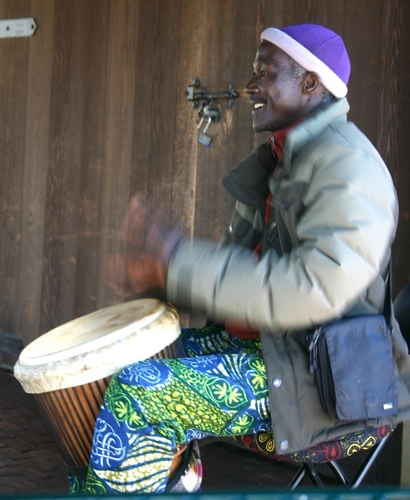GUILFORD — With its unveiling on Oct. 19, a new historical marker at the Southeastern Vermont Welcome Center on Interstate 91 now commemorates a multifaceted legacy of an 18th-century African American couple.
Abijah and Lucy Terry Prince were pioneers of African American land ownership in Vermont during the late 1700s, and Lucy Terry Prince's ballad poem, “Bars Fight,” is considered the oldest known work of literature by an African American, its 28 stanzas preserving an account of a 1746 conflict.
The marker was presented by State Historic Preservation Officer Laura V. Trieschmann in a ceremony that included remarks from Gretchen Gerzina, a former Guilford resident and author of Mr. and Mrs. Prince: How an Extraordinary Eighteenth-Century Family Moved Out of Slavery and Into Legend, and a performance of “Bars Fight” by poet and artist Shanta Lee Gander.
The Prince historical marker joins more than 300 such signs established by the State Historic Preservation Office and is the 19th to recognize African American history in Vermont.
This marker will also become one of more than 40 sites on the Brattleboro Words Trail, a public education project seeking to build a “shared pride of place” by recounting the history of writing, printing, publishing, and thought leadership in Windham County.
The Words Trail Project first mapped the Prince legacy in an mobile, immersive 2017 exhibit, “Lucy Speaks,” which featured a dramatic reading by Gander and a dance performance by Moon Livingston.
The marker also creates a new southernmost point on the Vermont African American Heritage Trail.
The brainchild of Curtiss Reed Jr. of Brattleboro and a collaborative partnership with a number of organizations statewide, the trail offers a statewide tour to “explore the lives and stories of African Americans in Vermont, and those dedicated to issues of freedom and equality,” according to the brochure available at the Vermont Department of Tourism and Marketing's website.
The Princes and their neighbors
Lucy Terry was born in Africa, abducted into slavery, and brought, via Rhode Island, to Deerfield, Mass., where she was eventually sold at age 5 to prominent landowner Ebenezer Wells. She worked as his “servant” for about 25 years.
There, by many accounts a prolific poet, she recounted in a poem the events of a 1746 massacre of two white families by 60 indigenous Abenaki fighters at the Bars, a Colonial term for “meadow.”
“Bars Fight” was preserved orally until Nov. 20, 1854, when it was first published in the Springfield Daily Republican.
As described on the historic marker, “Abijah Prince (c. 1706-94) served in the French & Indian Wars, as a slave and freedman. In 1751, he achieved his freedom and registered as a taxpayer and proprietor for land ownership.”
Abijah was among the 64 people to settle Sunderland, in Bennington County.
“Lucy became free sometime after they married in 1756,” the marker explains. “In 1769 they began settling 100 acres in Guilford.” The Princes had six children there.
But multiple frivolous lawsuits and feuds, spurred by racially charged, hostile neighbors, forced the Princes into legal action numerous times, where they won every lawsuit brought against them.
In 1785, Lucy would plead her case before Governor Thomas Chittenden and the Governor's Council, the highest tribunal in what at the time was the Republic of Vermont. The Council ruled in favor of the Princes, which prompted further retaliation from neighbors, including a violent home invasion.
Abijah died in 1794, and by 1803, Lucy had left Guilford for their Sunderland property.
She become the first woman to argue before a high court in Vermont. In 1796, by that time a septuagenarian, Lucy Terry Prince successfully fought to retain her property in Sunderland against land claims from a neighbor. She personally argued her case before the Vermont Supreme Court.
Lucy Terry Prince died in 1821. She lived to be several years shy of a full century.
In a marker, historical representation
Now commemorated at the most-visited welcome center in Vermont, the Prince legacy has the opportunity to be approached as a new example of dedication to diversity and inclusive historical representation.
“The concept of legacy becomes something I no longer have to imagine,” Gander said.
At the dedication, Guilford Selectboard Vice Chair Verandah Porche expressed her hopes the roadside marker will allow visitors to “come upon a marker that scratches the surface of an extraordinary history, and the Princes' challenging legacy.”
Porche sees the Prince story as an opportunity to reflect on Guilford's dedication to setting a welcoming tone that represents receptivity and a dedication to fairness. On a down-to-earth level, the recognition and inclusion of neighbors from racial and ethnic minorities require personal, practical measures, which Porche describes as “extending who we already are.”
A monument dedicated to the Prince legacy is a monument dedicated to the power of words, both how we voice and listen to them. Several days after the dedication, Gander said her approach to portraying Lucy Terry Prince in “Bars Fight” comes with the perspective of living in a technological age where “our words are made accessible to the broadest audience imaginable, but where very few are given the audience to perform.”
Gander attributes the legacy of “Bars Fight” to the ballad style that Prince used to write it.
“Ballad poetry was a form known to carry news,” Gander explained. “It's a form that supports a legacy.”
Lucy Terry Prince's legacy exemplifies a preservation of the past by giving words the utmost value with attention to a style that can outlast life itself.
“The African American presence is long and deep with miraculous things still to be discovered,” Gerzina wrote in her book. The Prince monument marks the future of what that legacy might shape.
